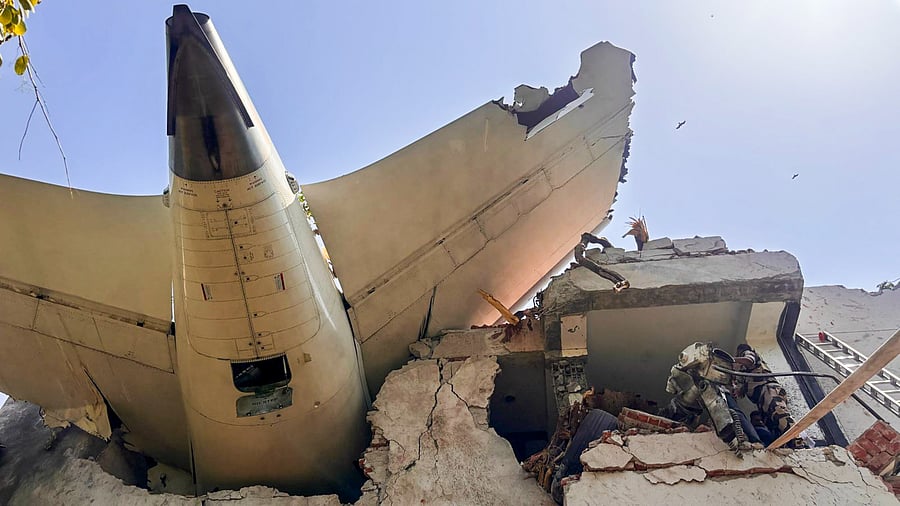
Remains of an Air India plane, that crashed moments after taking off from Sardar Vallabhbhai Patel International Airport, lies on a building, in Ahmedabad.
Credit: PTI Photo
New Delhi: The first report into the fatal Air India 171 crash in Ahmedabad says that the fuel supply to both the engines of the aircraft stopped just 3 seconds after the lift-off as fuel cut-off switches transitioned from RUN to CUTOFF position, one after the other, within a gap of 1 second.
These are the findings of the preliminary report of the Aircraft Accident Investigation Bureau (AAIB), made public a month after the crash of the Boeing 737 Dreamliner operating between Ahmedabad and London’s Gatwick Airport.
According to the sequence of events constructed by the probe agency, the fuel control switches were subsequently “moved from cut-off to run.” However, the engines could not induce core speed acceleration and recovery, resulting in one of the biggest civil aviation disasters, with the fuel-laden aircraft ramming straight into a hospital complex, killing all but one of the 242 people on board and 19 others on the ground.
In the data retrieved from the cockpit voice recorder, one of the pilots is heard asking the other why he had switched off the fuel supply. He responds by saying he hasn’t done anything like that. However, it is not disclosed in the report which pilot said what.
As the flight descended, one of the pilots transmitted “Mayday, Mayday, Mayday” and crashed within one minute of its takeoff.
It is a matter of investigation whether the transitions in the switch positions were done manually, inadvertently, or were triggered by an electronic malfunction.
Thereafter, as the aircraft lost thrust, the RAT—Ram Air Turbine—was activated immediately, indicating a loss of power supply to the aircraft systems.
A picture in the AAIB report shows the thrust levers were found to be in the idle position after the crash, but were in a takeoff position during the short duration the flight was airbourne.
At take-off, co-pilot Clive Kundar was the pilot flying the aircraft, while the captain Sumeet Sabharwal was the pilot-in-command monitoring the flight. Sabharwal had nearly 8,600 hours on the Boeing 787 under his belt, while Kundar had over 1,100 hours. The aircraft, a Boeing 737 Dreamliner with 10 crew members, was operating between Ahmedabad and London’s Gatwick Airport.
The report says the take-off weight of the aircraft was within prescribed limits under the existing conditions, and there were no dangerous goods on board.
Both engines crossed the take-off decision speed, consistent with the lift-off. Within 3 seconds, the aircraft achieved a maximum recorded speed of 180 knots, and immediately therafter, the fuel supply to both engines was switched off.
The report does not specify how the fuel supply was cut off, but the samples collected from the tank of the tanker used for refueling were tested and found to be satisfactory.
The investigation team is reviewing and examining further evidence to shed more light on the sequence of events that led to the crash.
At this stage, the report does not recommend any action to Boeing, or GE, the engine manufacturer, or Air India, the aircraft operator.
A day after the crash, the AAIB recovered the Cockpit Voice Recorders (CVR) from the rooftop of the hospital where the aircraft crashed. The Flight Data Recorders (FDR) were recovered from the debris on June 16, 2025.
AAIB, which operates under the Civil Aviation ministry, is tasked with investigating all air accidents involving aircraft with an All Up-Weight (AUW) of more than 2,250 kgs or turbojet aircraft.
The black boxes were brought to the AAIB lab in Delhi on June 24 and the data was extracted.